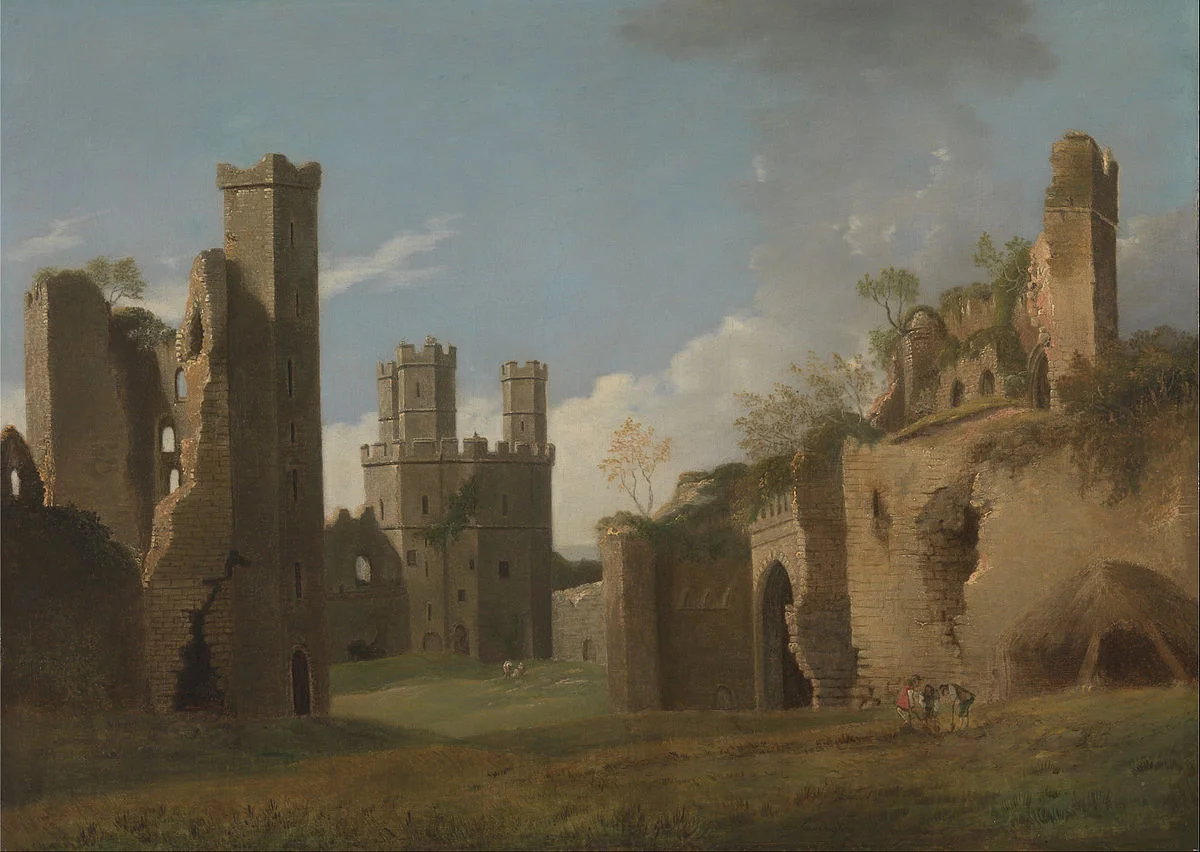Friday 16th June 1819
Friday July 16th About 10 o’clock my Mother & myself took a survey of the interior of Caernarvon Castle. It was built by Edward 1st. The form of it is a long irregular square at the west end is the
Eagle Tower where we saw the room in which Edward the 2nd was born in 1284 there are several other towers all communicating with each other by Galleries having wandered about these ruins for some time, for our guide having had a bad fall the day before left us to explore these by ourselves we returned to the hotel and amused ourselves for the remainder of the day. The gentlemen returned late in the evening.
OBSERVATIONS & COMMENTS:
Caernarfon Castle: There was a motte-and-bailey castle in the town of Caernarfon from the late 11th century. The Welsh recaptured Gwynedd in 1115, and Caernarfon Castle came into the possession of the Welsh princes. From contemporary documents written at the castle, it is known that Llywelyn the Great and later Llywelyn ap Gruffudd occasionally stayed at Caernarfon. In 1283 King Edward I defeated the Welsh and began replacing it with the current stone structure. Edward I and Eleanor of Castile, his queen arrived at Caernarfon on either 11 or 12 July 1283 and stayed for over a month. When Edward and Eleanor visited again in Easter 1284 the Eagle Tower may have been complete. According to tradition, Edward II was born at Caernarfon on 25 April 1284. Edward was created Prince of Wales in 1301, with control over Wales and its incomes. Since then the title has traditionally been held by the eldest son of the monarch.
Edward I creating his son, the later Edward II, prince of Wales, 1301. Text reads "Eduuardus factus est princeps Wallie" (Edward is made prince of Wales). Source British Library, MS Royal 20 A. ii, f. 10. Scanned from Prestwich, M.C. (2005) Plantagenet England: 1225-1360, Oxford: Oxford University Press, pp. plate 6 ISBN 0-19-822844-9 Author: Lampman. Licensing: This is a faithful photographic reproduction of a two-dimensional, public domain work of art. The work of art itself is in the public domain. https://commons.wikimedia.org/wiki/File:Edward_I_%26_II.jpg
Investiture of Charles, Prince of Wales, by Her Majesty Queen Elizabeth II at Caernarfon castle on 1st July 1968 - Image, Daily Post Wales from https://www.walesonline.co.uk/news/wales-news/prince-charles-investiture-bombs-how-15805211
The town and castle were sacked in 1294 when Madog ap Llywelyn led a rebellion against the English. Caernarfon was recaptured the following year. The castle was held by the Royalists during the Civil War and although it was taken by the Parliamentarians orders to slight it were not carried out. Although mostly complete externally, it was neglected after the Civil War and the interior buildings no longer survive. Many of the building plans were never finished until the 19th century when the state funded repairs. Farringdon’s painting, executed around the year 1780, shows the Eagle Tower in the centre with the state of the interior somewhat ruinous, which to the Romantics and tourists of the Regency period would have made it quite endearing.
In 1911, Caernarfon Castle was used for the investiture of the Prince of Wales, and again in 1969 https://en.wikipedia.org/wiki/Caernarfon_Castle
See also an excellent article The investiture of the Prince of Wales By Neil Evans, Honorary Research Fellow, School of History and Archaeology, Cardiff University at https://www.bbc.co.uk/wales/history/sites/investiture/pages/investiture-background.shtml
circa 1780: Caernarvon Castle, painting by Joseph Farington (1747 - 1821) in the collection of the Yale Center for British Art, Accession number YCBA/lido-TMS-340. The author died in 1821, so this work is in the public domain in its country of origin and other countries and areas where the copyright term is the author's life plus 100 years or less. https://commons.wikimedia.org/wiki/File:Joseph_Farington_-_Caernarvon_Castle_-_Google_Art_Project.jpg
With their guide leaving them early, Lucy and her mother wandered about the ruins and explored them for themselves. Lucy took time to open her sketchbook and drew the scene over two pages, which she captioned with today’s date.
Ten to fifteen years later the great artist, Joseph Mallord William Turner, added his impression of the Castle
The Eagle tower was the first tower to be completed, by the end of 1283. Daniel Mersey, in the Castles of Wales Website, writes: “Material for the building of the castle, town, walls, gates, and important quay were ferried in by sea. All of the initial building took place as a single operation, started in the summer of 1283. The first recorded entry of work was on the new castle's ditch, separating the castle from fortified town; this occurred on June 24th. Next, as with most castles built in enemy territory, a wooden barricade was erected to defend the building works from attack. Timber was shipped in from Liverpool, Rhuddlan, and Conway, and labourers began to cut the moat - this also supplied the rock for the walls (which were twenty foot thick at their base). The Welsh township was also demolished at this time. The only tower of the castle completed during the first phase of building was the Eagle Tower; the main priority was to make the site defensible, before later adding the impressive architecture of dominion's new capital. Work continued swiftly and the castle and town walls were substantially completed by late 1285. The architect for this first building phase was Master James of St George - a renowned and gifted castle architect - and from 1283-92, £12,000 had been spent.” http://www.castlewales.com/caernarf.html
This image, looking onto the Eagle Tower, is taken from a photostream at https://www.flickr.com/photos/ell-r-brown/27830118907
Can you help us?
Old Regency Prints, Pictures an Coaching maps: Do you have access to any prints or pictures showing what town and country would have looked like when Lucy travelled through? Any illustrations of what she would have seen in 1819 will enliven our research.
New Pictures: Do you have any modern pictures of the streets, buildings, gardens and views that would enable us to see the changes that two centuries have wrought?







